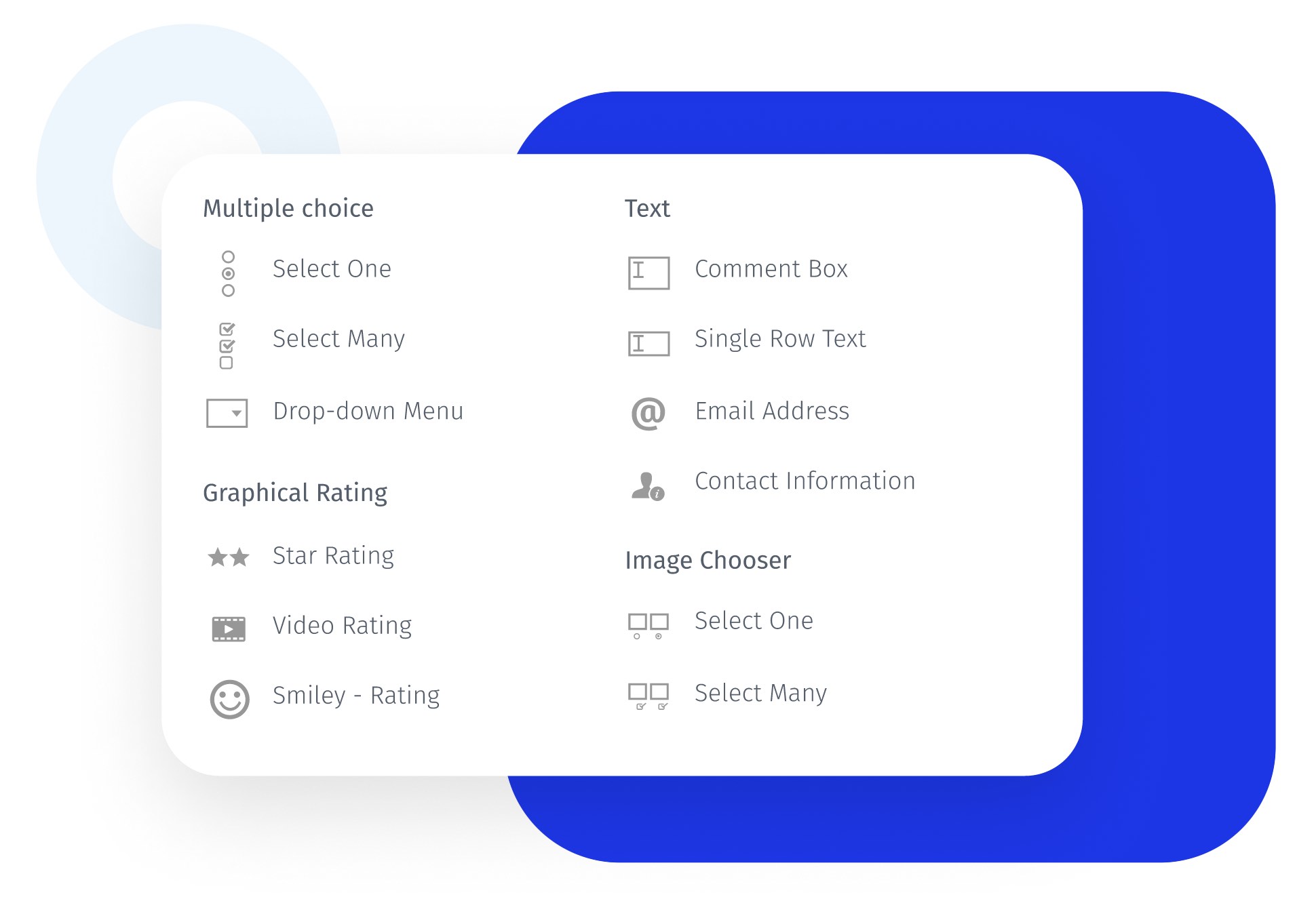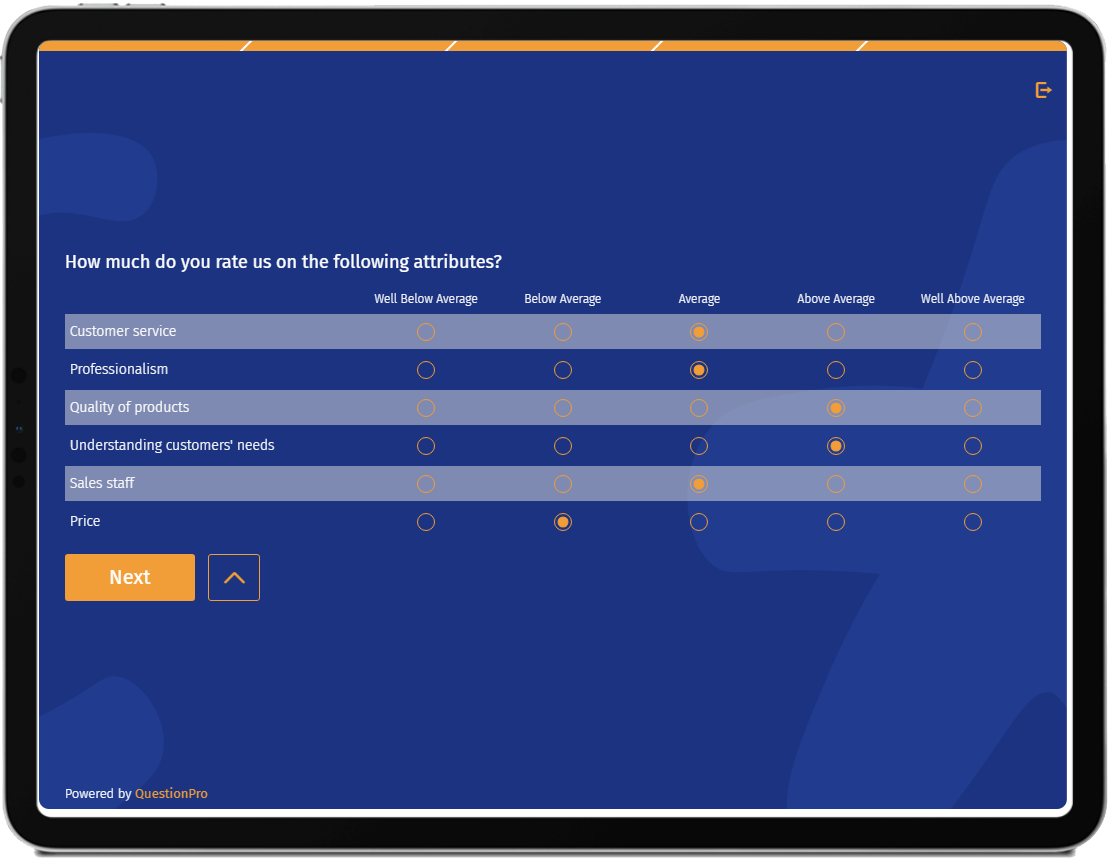It is a close-ended question with survey respondents having to select one of the given answer options.
Likert scale surveys are popular among market researchers as they collect feedback, opinions, and experience data. They are simple, easy to use, and easy to answer. Likert scales can help you discover the strengths and areas for improvement in your product or service offering.
Compared to 'Yes/No' questions, the Likert scale survey questions give you the degree of the respondents' experience. It is not enough to know at times whether they felt satisfied or not. Likert scale questions find out to what extent they felt satisfied or dissatisfied.
Example of A Likert Scale Survey Question
Likert scale surveys are used in different types of customer, employee, and event surveys. Some of the common Likert scale examples are below:
Customer satisfaction survey: Likert scale customer satisfaction questions are an excellent option for businesses to know if their customers are satisfied with their products and services.

Customer service survey: This type of Likert survey questions includes a 5-point Likert scale questionnaire to collect customer feedback after an interaction with a customer support executive. The options range from 'Not so helpful' to 'Very helpful'.
Types of Likert Scale Surveys
Likert scale surveys are commonly used in fields like market research, psychology, and social sciences to measure people's attitudes, opinions, and behaviors. These surveys can help you capture how strongly people feel about a statement or question.
The scale usually goes from one extreme to the other, with a neutral option in the middle. Using Likert scales helps you collect detailed data that can be analyzed to find trends and patterns.
Likert scales are flexible and can be adapted to various types of questions, making them useful tools for designing surveys. They can be used to measure agreement, frequency, importance, likelihood, and quality, among other things.
To design effective Likert scale surveys, make sure the scale is balanced and the questions are clear and straightforward. This will help you get reliable and accurate responses that truly reflect people's views.
Unipolar Likert Scale Surveys
This type of survey uses a single adjective on the response scale. It pushes respondents to think of a product or service attribute in a specific direction. Respondents need to feel the presence or absence of quality.
For instance, consider the question, 'How helpful is this article?' The options on a 5-point scale can be: Not at all helpful, slightly helpful, neutral, slightly helpful, and very helpful.
The above question makes a respondent think about the 'helpfulness' of the article - a single quality and is an example of a Likert scale question.
Bipolar Likert Scale Surveys
Bipolar Likert scale surveys use opposite adjectives on the ends of the scale. For instance, consider the question, 'How satisfied are you with our products?' The options on a 5-point range can be extremely dissatisfied, somewhat dissatisfied, neutral, somewhat satisfied, and extremely satisfied.
Uses of A Likert Scale Survey
Likert scale surveys are useful tools that help understand people's attitudes, feelings, and experiences. They are designed to make it easy to measure and analyze this information. Here are some ways Likert scale surveys can be used:
Course evaluation survey: Universities can use a Likert scale survey question type to know if the students were satisfied with the courses they took that semester. The rating scales can range from 'Strongly Agree' to 'Strongly Disagree'.
Employee satisfaction survey: Consider an organization that recently took its employees for an outing. To know whether the employees enjoyed the experience, they can conduct a Likert scale survey.
Event feedback survey: The event organizers can use Likert scale responses to know what areas of the event were liked by the attendees and what needed to be better.
Advantages of A Likert Scale Survey
Likert scale surveys are widely used due to their numerous advantages in collecting and analyzing data. Here are some key benefits:
Measure the degree of experience: The Likert scale questionnaire collects the degree of experience of the respondents. Just knowing whether someone had a good experience or not is not enough survey data to gather actionable insights. The Likert scale data helps you measure the extent of their current experience. You can compare it with the historical data and see if it has improved over time.
Simple and easy-to-use: With QuestionPro Surveys, you can create a Likert scale survey using different question types. Also, you can use a Likert scale survey template from the Likert scale template library. They are quite simple and easy to use; all it requires users is to drag and drop the question and set the answer options.
Great experience for the respondents: Answering the Likert scale survey is extremely easy. Respondents need to click on the answer option they want to submit. It doesn't take much time or effort to answer this question type, which boosts the survey completion rate.
How to Set Up And Create A Likert Scale Survey in Your Research?
Create Likert scale surveys and questionnaires easily. Whether you're collecting feedback or conducting research, QuestionPro’s Likert scale creator allows you to add a Likert rating scale to any survey effortlessly. You'll be able to quickly share the Likert scale survey results and gain valuable insights that can help you improve for your customers.
Learn how to set up and use this feature with our help file on the Likert scale survey questions.
Survey Software Easy to use and accessible for everyone. Design, send and analyze online surveys.
Research Suite A suite of enterprise-grade research tools for market research professionals.
Customer Experience Experiences change the world. Deliver the best with our CX management software.
Employee Experience Create the best employee experience and act on real-time data from end to end.






